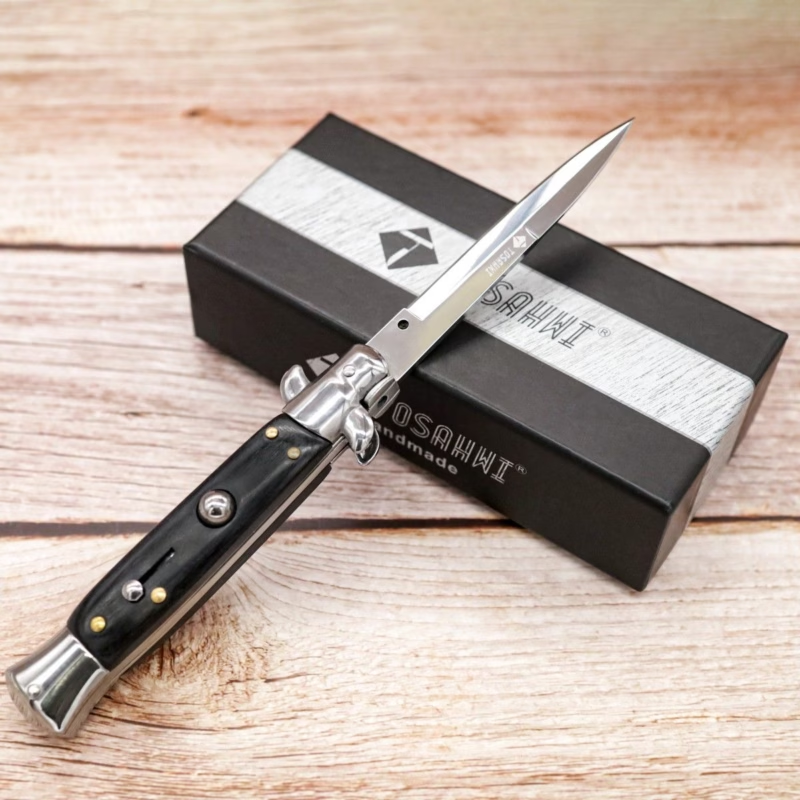What is a Switchblade? Switchblade 101

Introduction
A switchblade is a type of automatic knife that opens with the press of a button, switch, or lever. Known for their quick deployment and sleek design, switchblades have fascinated collectors, law enforcement, and the general public for centuries. This article aims to provide an in-depth understanding of switchblades, including their mechanics, history, legality, and cultural significance, while also addressing responsible usage and safety concerns.

Understanding Switchblades
Mechanism
A switchblade operates on a simple but effective mechanism: a spring-loaded blade that deploys automatically when activated. The action is typically triggered by a button or switch located on the handle. When the button is pressed, the internal spring pushes the blade out of the handle, making the switchblade a convenient and fast-opening knife.
Types of Switchblades
Switchblades come in various designs, each with unique characteristics:
- Side-Opening: This is the most common type of switchblade. The blade opens from the side of the handle, similar to a conventional folding knife, but it opens automatically with a push of a button.
- Out-the-Front (OTF): In this design, the blade slides out of the front of the handle when activated. This type is often seen as more visually striking, and its spring-loaded mechanism makes it particularly fast and reliable.
- Single vs. Double Action: A single-action switchblade only opens when the button is pushed, but the blade must be manually retracted. A double-action switchblade, on the other hand, can both open and retract with a single push of the button, offering greater convenience.
Historical Background
Origins
The switchblade’s history dates back to the mid-18th century in Europe. Early versions of automatic knives were created in Italy and France, where they were often used by military personnel and travelers as practical tools. These knives were originally high-end items, prized for their fast-opening capability and elaborate craftsmanship.
Evolution
As time passed, switchblades became more accessible. In the early 20th century, with advancements in manufacturing, these knives were mass-produced and became widely available to the general public. By the 1950s, switchblades were commonly carried by individuals across the world, especially in urban areas.
Cultural Impact
Switchblades became more than just a tool—they became symbols of rebellion and delinquency. In the 1950s, they were frequently featured in Hollywood films, including West Side Story and Rebel Without a Cause, where they were often associated with gang culture. This sensationalized portrayal contributed to the public’s wariness of switchblades, and they soon became linked to juvenile delinquency, further impacting their reputation.
Legal Landscape
United States
In the U.S., the regulation of switchblades is complex and varies by state. At the federal level, the Federal Switchblade Act of 1958 regulates the interstate commerce of switchblades, making it illegal to transport them across state lines if they are banned in the state of destination. However, state laws differ significantly:
- California: Switchblades are illegal in the state, although certain exceptions exist for law enforcement and military personnel.
- Texas: Switchblades are legal to own and carry, provided certain conditions are met, such as the knife being under a specific length.
In recent years, there have been challenges to the legality of switchblade bans. For example, in 2024, Massachusetts’ Supreme Judicial Court struck down the state’s ban on switchblades, stating that it violated the Second Amendment rights of citizens.
United Kingdom
In the UK, the manufacture, sale, or possession of switchblades is prohibited under the Restriction of Offensive Weapons Act 1959. This law was passed in response to concerns about the use of switchblades in crimes and public disturbances. Violating the law can lead to severe penalties, including imprisonment.
Recent Developments
Despite decades of regulation, some jurisdictions have started revisiting switchblade laws. In 2024, Massachusetts became a key example when its top court ruled in favor of allowing citizens to possess switchblades. This case highlighted the changing public perception of such knives, as many see them as useful tools rather than dangerous weapons.
Switchblades in Popular Culture
Switchblades have maintained a strong presence in popular culture, largely due to their association with rebellious youth in the 1950s. Films like West Side Story and Rebel Without a Cause cemented the knife’s place as a symbol of youth defiance. Switchblades were also used to add an element of danger or edginess to characters in these films.
In modern times, however, switchblades have shifted from being icons of delinquency to collectible items or tools. Collectors often appreciate the craftsmanship involved in making high-quality switchblades, while others see them as practical devices for self-defense or outdoor activities.
Safety and Ethical Considerations
Responsible Use
Owning a switchblade comes with a responsibility to use it properly and in accordance with the law. Always be aware of the specific laws in your region regarding switchblade ownership and use. For example, some areas prohibit switchblades entirely, while others allow them under certain conditions. Always carry your knife safely, and never use it in an inappropriate or unlawful manner.
Ethical Sourcing
It is important to purchase switchblades from reputable manufacturers who ensure ethical practices. This includes ensuring that the materials used are sourced responsibly and that the production process adheres to high labor standards. Supporting companies that care about the environment and ethical manufacturing processes can contribute to a more sustainable industry.
Conclusion
Switchblades are unique knives with a rich history and fascinating mechanics. They have evolved from luxury items in Europe to mainstream tools and even cultural symbols of rebellion. However, their place in modern society is nuanced. While they are legal in some places, they remain heavily regulated in others. Whether you’re interested in their historical significance, mechanical design, or legal status, it’s important to approach switchblade ownership responsibly.
If you’re considering adding a switchblade to your collection or for practical use, make sure to stay informed about the laws in your area, use it responsibly, and purchase from trusted sources.




